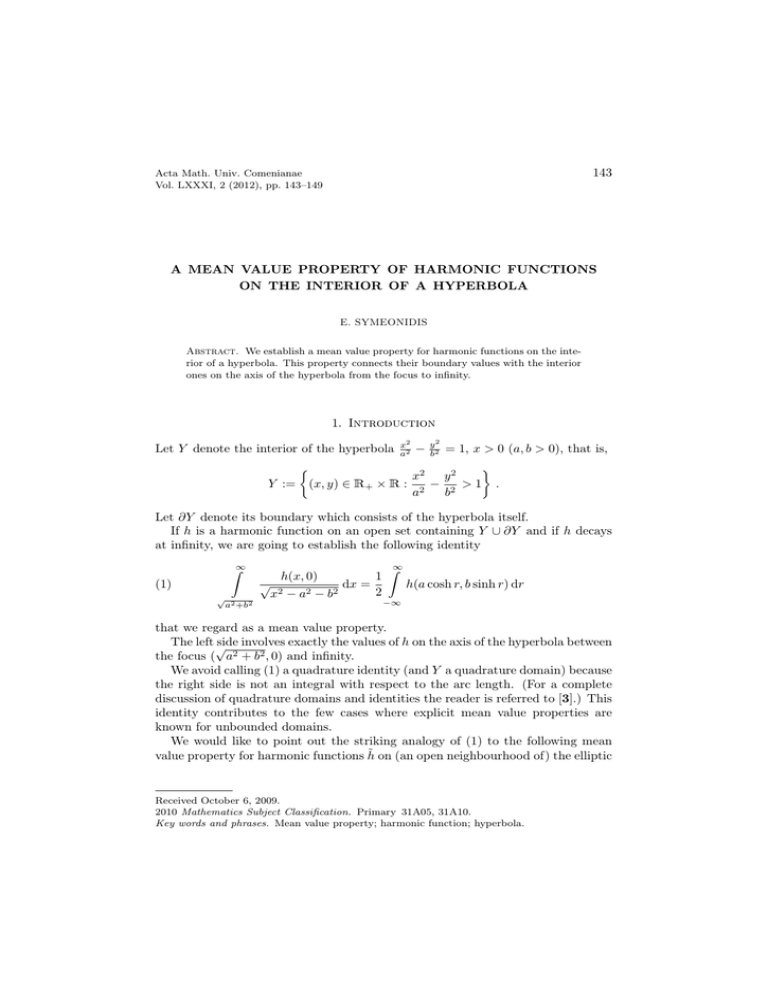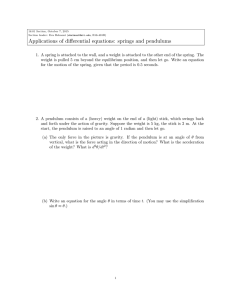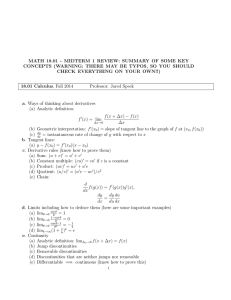143 A MEAN VALUE PROPERTY OF HARMONIC FUNCTIONS
advertisement

143
Acta Math. Univ. Comenianae
Vol. LXXXI, 2 (2012), pp. 143–149
A MEAN VALUE PROPERTY OF HARMONIC FUNCTIONS
ON THE INTERIOR OF A HYPERBOLA
E. SYMEONIDIS
Abstract. We establish a mean value property for harmonic functions on the interior of a hyperbola. This property connects their boundary values with the interior
ones on the axis of the hyperbola from the focus to infinity.
1. Introduction
Let Y denote the interior of the hyperbola
Y :=
(x, y) ∈
x2
a2
R+ × R
−
y2
b2
= 1, x > 0 (a, b > 0), that is,
y2
x2
: 2 − 2 >1 .
a
b
Let ∂Y denote its boundary which consists of the hyperbola itself.
If h is a harmonic function on an open set containing Y ∪ ∂Y and if h decays
at infinity, we are going to establish the following identity
Z∞
(1)
√
a2 +b2
h(x, 0)
1
√
dx =
2
2
2
2
x −a −b
Z∞
h(a cosh r, b sinh r) dr
−∞
that we regard as a mean value property.
The left √
side involves exactly the values of h on the axis of the hyperbola between
the focus ( a2 + b2 , 0) and infinity.
We avoid calling (1) a quadrature identity (and Y a quadrature domain) because
the right side is not an integral with respect to the arc length. (For a complete
discussion of quadrature domains and identities the reader is referred to [3].) This
identity contributes to the few cases where explicit mean value properties are
known for unbounded domains.
We would like to point out the striking analogy of (1) to the following mean
value property for harmonic functions h̃ on (an open neighbourhood of) the elliptic
Received October 6, 2009.
2010 Mathematics Subject Classification. Primary 31A05, 31A10.
Key words and phrases. Mean value property; harmonic function; hyperbola.
144
disc
E. SYMEONIDIS
x2
a2
+
y2
b2
≤ 1 (here a > b > 0)
√
a
Z2 −b2
(2)
√
− a2 −b2
1
h̃(x, 0)
√
dx =
2
2
2
2
a −b −x
Zπ
h̃(a cos s, b sin s) ds
−π
(see [5], [6]). For the proof of (1) we do not use (2). Nevertheless, we believe that
it is worth looking for a deeper connection between (1) and (2).
2. The mean value property
A simple dilatation transforms the hyperbola
x2
cos2 s0
−
y2
sin2 s0
= 1 with s0 ∈ ]0,
Z∞
(3)
1
π
2[
h(x, 0)
1
√
dx =
2
x2 − 1
x2
a2
−
y2
b2
= 1 to the “standard” form
and (1) takes the form
Z∞
h(cosh r cos s0 , sinh r sin s0 ) dr.
−∞
For s ∈ ]0, s0 ], we put
R+ × R : cosx 2 s − siny 2 s > 1
2
Ys :=
(x, y) ∈
2
.
Every hyperbola ∂Ys is parametrized by the map
2
−→
.
r 7−→ (cosh r cos s, sinh r sin s)
R
R
A simple computation shows
hyperbolae ∂Ys correspond to differS that disjoint
ent s ∈ ]0, π2 [ and Ys0 =
∂Y
∪
([1,
∞[ ×{0}) holds. Thus, Ys0 can be
s
0<s<s0
parametrized by
F (r, s) := (cosh r cos s, sinh r sin s) ,
where (r, s) ∈ × ] − s0 , s0 [ (F (r, s) = F (−r, −s)). Since F (r, s) = cosh(r + is), F
is a conformal mapping and the Laplacian in the coordinates r, s keeps its euclidean
∂2
∂2
form ∂r
2 + ∂s2 .
R
The method we apply for obtaining (3) is the solving of the Dirichlet problem for Ys0 by separation of variables in the Laplace equation. To this end, let
f : ∂Ys0 →
be a continuous function. We assume that f (F (r, s)) decreases
fast enough for r → ±∞ so that all integrals in the sequel converge. A Dirichlet
solution for (Ys0 , f ) is a harmonic function Hf : Ys0 →
which is continuously
extendable to ∂Ys0 by f . We require Hf to be bounded.
R
R
The method of separation of variables starts with the determination of all harmonic functions u : Ys0 → of the form
R
u (F (r, s)) = U (r)V (s) .
The Laplace equation
∂ 2 (u ◦ F ) ∂ 2 (u ◦ F )
+
=0
∂r2
∂s2
A MEAN VALUE PROPERTY OF HARMONIC FUNCTIONS
145
entails
U 00 (r) V 00 (s)
+
≡0
U (r)
V (s)
U 00
V 00
=−
=: γ ∈
U
V
so
R.
The following cases have to be examined separately.
Case 1. γ < 0: We write γ = −λ2 with λ > 0 and have
V (s) = a cosh(λs) + b sinh(λs) ,
R
U (r) = c cos(λr) + d sin(λr)
R
for r ∈ , |s| < s0 with a, b, c, d ∈ . While combining U and V to obtain u, we
have to pay attention to the condition u (F (r, s)) = u (F (−r, −s)) which results in
the basic functions
(4)
cos(λr) cosh(λs)
and
sin(λr) sinh(λs)
for u (cos(λr) sinh(λs) and sin(λr) cosh(λs) have to be rejected). At this point it
is still unsettled whether (4) represent harmonic functions in the cartesian coordinates x, y. The reason is that F is singular for (r, s) = (0, 0) which means that
(4) may not be smooth at the focus (x, y) = (1, 0) of the hyperbola.
However, the harmonicity of sin(λr) sinh(λs) is guaranteed by the reflection
principle, since it is an odd function with respect to y (see, e. g. [1, Theorem 1.3.6]).
Then, also cos(λr) cosh(λs) is harmonic as a harmonic conjugate function (a conjugate with respect to (x, y), which must exist, has to be conjugate with respect
to (r, s), too).
Case 2. γ > 0: Here we write γ = λ2 with λ > 0 and have
V (s) = a cos(λs) + b sin(λs) ,
R
for r ∈ , |s| < s0 with a, b, c, d ∈
in the basic functions
R.
cosh(λr) cos(λs)
U (r) = c cosh(λr) + d sinh(λr)
The condition F (r, s) = F (−r, −s) results
and
sinh(λr) sin(λs) .
We are not going to further examine these functions because they are unbounded
on Ys0 .
Case 3. γ = 0: Here we have
V (s) = as + b ,
U (r) = cr + d .
The only bounded functions u with u (F (r, s)) = u (F (−r, −s)) are the constant
ones.
After the determination of the basic harmonic functions of separate variables
we return to the Dirichlet setting and assume that the (bounded) solution Hf can
be expressed in the form
Z∞
(5) Hf (F (r, s)) = c +
Z∞
aλ cosh(λs) cos(λr) dλ +
0
bλ sinh(λs) sin(λr) dλ
0
146
E. SYMEONIDIS
with appropriate coefficient functions aλ , bλ . If the right side is continuously extendable to s = s0 , the boundary condition implies
f (F (r, s0 ))
(6)
Z∞
=c+
Z∞
aλ cosh(λs0 ) cos(λr) dλ +
0
bλ sinh(λs0 ) sin(λr) dλ .
0
Since by assumption the left side tends to zero for r → ±∞, on the basis of the
Riemann-Lebesgue lemma it should hold c = 0 provided that aλ cosh(λs0 ) and
bλ sinh(λs0 ) are integrable in λ. (For this lemma and the following facts about the
Fourier transform, see, e. g. [2].) Then, (6) is nothing but the Fourier inversion
formula which at the same time forces aλ cosh(λs0 ) and bλ sinh(λs0 ) to constitute
the Fourier transform of r 7→ f (F (r, s0 )) as follows:
1
aλ cosh(λs0 ) =
π
(7)
bλ sinh(λs0 ) =
1
π
Z∞
f (F (r, s0 )) cos(λr) dr ,
−∞
Z∞
f (F (r, s0 )) sin(λr) dr .
−∞
At this point we have to clarify the conditions under which all previous plausible conclusions are allowed. By Fourier theory we know that if the function
r 7→ f (F (r, s0 )) is integrable and twice differentiable with integrable first and second derivative, then the left sides of (7) are integrable, (6) holds with c = 0, and
(5) solves the Dirichlet problem for (Ys0 , f ). We remark that this Hf is a bounded
function on Ys0 .
Substituting aλ and bλ in (5) by their expressions from (7) and interchanging
of integration lead to the following representation of the Dirichlet solution
Hf (cosh r cos s, sinh r sin s)
Z∞
Z∞
cosh(λs) cos(λr) cos(λρ)
=
f (cosh ρ cos s0 , sinh ρ sin s0 ) ·
dλ dρ
π cosh(λs0 )
−∞
0
Z∞
Z∞
f (cosh ρ cos s0 , sinh ρ sin s0 ) ·
+
−∞
sinh(λs) sin(λr) sin(λρ)
dλ dρ
π sinh(λs0 )
0
Z∞
=
f (cosh ρ cos s0 , sinh ρ sin s0 )
−∞
Z∞ ·
cosh(λs) cos(λr) cos(λρ) sinh(λs) sin(λr) sin(λρ)
+
dλ dρ,
π cosh(λs0 )
π sinh(λs0 )
0
where the inner integral can be regarded as a Poisson kernel.
A MEAN VALUE PROPERTY OF HARMONIC FUNCTIONS
147
In particular, for s = 0, we have
Hf (coshr, 0)
Z∞
Z∞
(8)
cos(λr) cos(λρ)
=
f (cosh ρ cos s0 , sinh ρ sin s0 ) ·
dλ dρ .
π cosh(λs0 )
−∞
0
At this point we need the following lemma.
R
Lemma. Let g : ∂Ys0 → be a bounded continuous function. Then there exists
at most one bounded solution to the Dirichlet problem for (Ys0 , g).
R
Proof. It suffices to show that if g = 0 and the bounded function h : Ys0 →
solves the Dirichlet problem for (Ys0 , g), then h = 0.
Let 2 ∪ {∞} be the one-point compactification of 2 , ∂∞ Ys0 := ∂Ys0 ∪ {∞}
the boundary of Ys0 in 2 ∪ {∞}. Since {∞} is a polar subset of 2 ∪ {∞}, under
the above assumptions it holds
R
R
R
lim h(z) = 0
z→w
z∈Ys
0
R
for every w ∈ ∂Ys0
and therefore for quasi-every point w ∈ ∂∞ Ys0 . By a theorem of Bouligand (see
[4]), this implies h = 0.
Thus, if h is a bounded harmonic function on an open neighbourhood of
Ys0 =
Ys0 ∪∂Ys0 , h is the unique solution of the Dirichlet problem for Ys0 , h|∂Ys0 , and if
in addition the function r 7→ h (F (r, s0 )), (r ∈ ) as well as its first two derivatives
are integrable, (8) entails
R
h(cosh r, 0)
Z∞
(9)
Z∞
h(cosh ρ cos s0 , sinh ρ sin s0 ) ·
=
−∞
cos(λr) cos(λρ)
dλ dρ .
π cosh(λs0 )
0
Due to the inner integral and the arbitrariness of r, this equation, though crucial
in our investigation, is not yet “simple” enough to present a mean value property
that deserves its name. However, it results in a whole class of such properties after
being multiplied by suitable functions and integrated. Let α = α(r) be a function
for which the Fourier cosine transform and its inversion are applicable (see, e. g.
[2])
Z∞
α(r) cos(λr) dr =: βλ cosh(λs0 ) ,
0
2
α(r) =
π
Z∞
βλ cosh(λs0 ) cos(λr) dλ.
0
148
E. SYMEONIDIS
Then, from (9) we get
Z∞
Z∞
h(cosh r, 0)α(r) dr =
h(cosh ρ cos s0 , sinh ρ sin s0 )
−∞
Z∞
0
·
(10)
cos(λρ)
π cosh(λs0 )
0
Z∞
Z∞
α(r) cos(λr) dr dλ dρ
0
Z∞
h(cosh ρ cos s0 , sinh ρ sin s0 ) ·
=
−∞
βλ
cos(λρ) dλ dρ.
π
0
Indeed, relation (10) is a generator of many mean value properties. We shall
2
look closer into the special case βλ = e−cλ , c > 0; its Fourier cosine transform
can be explicitly given
Z∞
(11)
−cλ2
e
1
cos(λρ) dλ =
2
r
π − ρ2
e 4c
c
0
([2, p. 223]). In this case we have
Z
Z
1 ∞ −cλ2 eλs0 + e−λs0
1 ∞
βλ cosh(λs0 ) cos(λr) dλ =
e
·
cos(λr) dλ
α(r) =
π −∞
π −∞
2
1
=
2π
Z∞
−cλ2 +λs0
e
1
cos(λr) dλ +
2π
−∞
1
=
2π
Z∞
»
−c
2
(λ− s2c0 )
s2
− 4c02
−∞
−λs0
cos(λr) dλ
–
Z∞
1
cos(λr) dλ +
2π
e
»
–
s2
s0 2
−c (λ+ 2c
) − 4c02
cos(λr) dλ
−∞
Z∞
s
e
0
−c(λ− 2c
)
2
−∞
1 s20
=
e 4c
2π
2
e−cλ
−∞
e
1 s20
=
e 4c
2π
Z∞
1 s20
cos(λr) dλ +
e 4c
2π
Z∞
s0
2
e−c(λ+ 2c ) cos(λr) dλ
−∞
Z∞
e
−cx2
s0 r 1 s20
cos xr +
dx +
e 4c
2c
2π
−∞
Z∞
2
s0 r e−cx cos xr −
dx
2c
−∞
1 s20
s0 r
= e 4c cos
·
π
2c
Z∞
2
s2
2
1
s0 r
0 −r
e−cx cos(xr) dx = √ e 4c cos
2c
cπ
−∞
according to (11). Using (10) and (11), we arrive at the following theorem.
A MEAN VALUE PROPERTY OF HARMONIC FUNCTIONS
149
Theorem. Let h be a bounded harmonic function on an open neighbourhood
of Ys0 for which r 7→ h(cosh r cos s0 , sinh r sin s0 ) and its first two derivatives are
integrable over . Then, for every c > 0, it holds
Z∞
2
s2
s0 r
0 −r
h(cosh r, 0) · e 4c cos
dr
2c
0
(12)
Z∞
ρ2
1
h(cosh ρ cos s0 , sinh ρ sin s0 ) · e− 4c dρ.
=
2
R
−∞
If we pass to the limit c → ∞ in (12), we obtain (since s0 can be replaced by
any smaller number) the following corollary.
Corollary. Under the hypotheses of the theorem it holds
Z∞
Z∞
1
h(cosh r, 0) dr =
h(cosh r cos s, sinh r sin s) dr
2
0
−∞
for every s ∈ [0, s0 ].
This establishes (3).
References
1. Armitage D. H. and Gardiner S. J., Classical Potential Theory, Springer, 2001.
2. Folland G. B., Fourier Analysis and its Applications, Wadsworth & Brooks/Cole, Belmont
(California), 1992.
3. Gustafsson B. and Shapiro H. S., What is a quadrature domain? , in “Quadrature Domains
and Applications — a Harold S. Shapiro Anniversary Volume” (eds. Ebenfelt P., Gustafsson
B., Khavinson D., Putinar M.), Operator Theory: Advances and Applications, Vol. 156,
Birkhäuser, 2005; as a pdf-file available under www.math.kth.se/∼gbjorn/qd.pdf.
4. Helms L. L., Introduction to Potential Theory, John Wiley & Sons, Inc., 1963.
5. Royster W. C., A Poisson Integral Formula for the Ellipse and some Applications, Proc.
Amer. Math. Soc. 15 (1964), 661–670.
6. Symeonidis E., A Mean Value Property of Harmonic Functions on Prolate Ellipsoids of
Revolution, Acta Math. Univ. Comenianae Vol. LXXVII(1) (2008), 55–61.
E. Symeonidis, Mathematisch-Geographische Fakultät, Katholische Universität Eichstätt-Ingolstadt, Ostenstr. 26-28, 85072 Eichstätt, Germany, e-mail: e.symeonidis@ku-eichstaett.de








